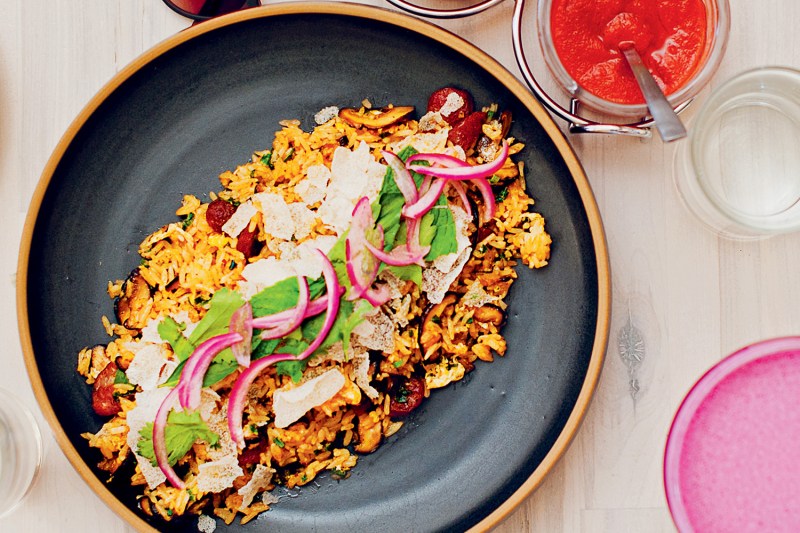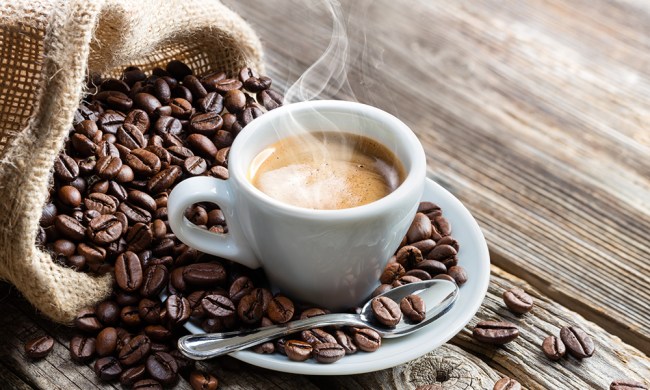According to The Peached Tortilla’s creator Eric Silverstein, making fried rice well is “almost like a rite of passage if you’re Chinese.” Silverstein, a former litigator-turned-fusion-cuisine mogul, also has other ideas about what does or does not constitute good fried rice. In his new book, (Sterling Epicure 2019), he lays out his thoughts on the dish, including what kind of rice to use, what proteins to use, and more.
While we are lovers of fried rice, we didn’t know the first thing about making it right, so this book came at the perfect time. His recipe for fried rice below is not only pretty easy to follow, it is also tastier than anything you’ll find at your run-of-the-mill takeout spot.
One thing we’ve realized, too, is that fried rice is something that we can do with what we have in the house. Utilizing leftovers or the bits and pieces of veggies or meats that didn’t get used in previous dishes, we’ve been able to take this recipe and run with it. While we’d love to follow the recipe by the book when we can, sometimes you’ve got to improvise. Don’t have white pepper? Well, time for black pepper. No Lap Cheong, but you’ve got another type of sausage? Great, it’s going in. That’s the thing about rules — you can learn them, then break them.
The Peached Tortilla’s Fried Rice Recipe

(Serves 4)
“Making good fried rice is almost like a rite of passage if you’re Chinese. The great thing about cooking a lot of rice at home is you are bound to have some left over. There’s an ongoing debate as to whether or not day-old rice makes fried rice better. I tend to think it does, mainly because a lot of the surface moisture evaporates from the rice overnight and your fried rice ends up sticking together less. If you are going to fry day-old rice, you will need to make it the day before, and then refrigerate it, loosely covered, overnight. To me, there’s no real right or wrong, in terms of the vegetables and proteins you can add to fried rice. However, I do think there’s a process to follow and certain key ingredients to include. Depending on the size of the pan you’re using, you may need to split this recipe in two.”
Ingredients:
- 4 tbsp vegetable oil
- 2 cloves garlic, minced
- .25-inch knob peeled ginger, minced on a microplane (about 2 tsp)
- .5 pound Lap Cheong (Chinese sausage)
- 25 c shiitake mushrooms, stems removed, cleaned and sliced
- .5 cup green onions, chopped
- 2 eggs, beaten
- 2 heavy pinches white pepper
- 4 c cold, day-old jasmine rice (already cooked)
- 5 tbsp butter
- 1 tsp Shiro Miso
- 3 tbsp oyster sauce
- Cilantro, for garnish
- 1 c rice puffs (from 1 rice paper wrapper) (optional) (see Note)
- .25 cup Peach Pickled Red Onions* (see below) or julienned red onions
Method:
- In a wok or a large pan, heat 3 tablespoons of the oil over low heat. When the oil starts to shimmer, add the garlic and ginger.
- When the garlic and ginger have become aromatic, add the lap cheong, shiitake mushrooms, and green onions. Continue to stir-fry all the ingredients over medium heat for 3 minutes.
- Move the lap cheong mixture to a separate plate. Heat 1 tablespoon of oil in the empty pan over medium-low heat. Add the beaten eggs and scramble them. Season the eggs with a heavy pinch of white pepper.
- It’s really important to create a layer of oil in the pan, between the pan itself and the eggs. This will prevent the eggs from sticking to the pan. When you add the 1 tablespoon of vegetable oil to the empty pan, make sure it spreads over the bottom of the pan, and then pour the beaten eggs directly on top of the oil.
- Once the scrambled eggs are cooked, place the lap cheong mixture back into the pan. Add the 4 cups of cold rice and increase the heat to high.
- Add the butter, shiro miso, oyster sauce, and a heavy pinch of white pepper to the pan. Stir-fry the mixture over medium-high heat for 3–4 minutes, making sure to incorporate all the ingredients.
- Place the fried rice on a big serving platter, and top the rice with cilantro, rice puffs, and peach pickled red onions.
Note: Rice puffs are simple to make and give a great texture to a lot of dishes. Heat 2 quarts of oil in a pot to 350 degrees Fahrenheit. Then, gently place the rice paper wrappers into the oil. The rice papers should immediately puff up and you should really be able to smell the fried rice paper. Immediately remove the rice puffs with a spider or a slotted stainless steel spoon and set them on a plate covered with a paper towel. The rice papers should only fry for 10 seconds. Once the rice puffs have cooled, break them up with your hands into 1⁄2 × 1⁄2-inch pieces.
*Peached Pickled Red Onions
(Makes 1 quart)
“The aromatics and peach tea in this recipe really help infuse the red onions with flavor. We like to use them in the restaurant, not only for their great flavor, but for their appearance as well — they look great on top of a dish. If you’re cooking for guests, sprinkle some on top of a robust, savory dish that has a high fat content. It will taste fantastic.”
Ingredients:
- 1 bag of peach tea
- .5 c rice wine vinegar
- 2 tbsp sugar
- .5 tbsp salt
- 1 red onion, julienned
- 2 pods Star Anise
- 2 cloves garlic
- 2 bay leaves
- 1 Thai Chili
Method:
- Bring 1 cup of water to a boil in a small saucepan. Steep the tea bag in the water, according to the directions on the bag.
- Add the rice wine vinegar, sugar, and salt to the saucepan until the sugar and salt have dissolved, and then let the mixture rest for 5 minutes.
- Place the red onions, star anise, garlic cloves, bay leaves, and Thai chili in 16-ounce mason jars. Add the pickling liquid to the mason jars and secure the lids tightly.
You can purchase The Peached Tortilla here.
Recipe and image courtesy of The Peached Tortilla by Eric Silverstein. Sterling Epicure 2019.



